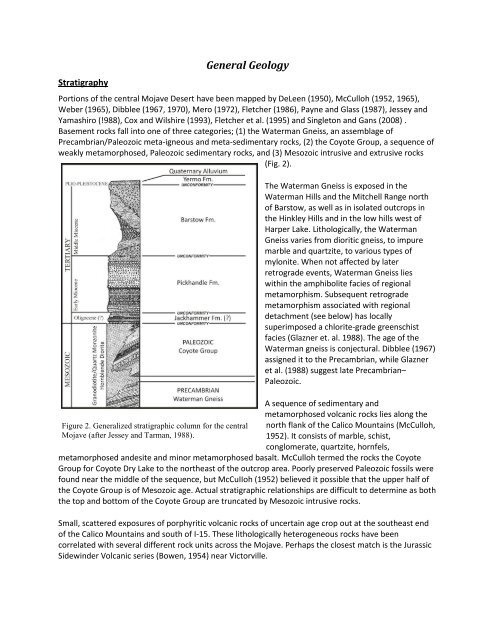Geology and Ore Genesis of Silver–Barite Mineralization in the ...
Geology and Ore Genesis of Silver–Barite Mineralization in the ...
Geology and Ore Genesis of Silver–Barite Mineralization in the ...
Create successful ePaper yourself
Turn your PDF publications into a flip-book with our unique Google optimized e-Paper software.
Stratigraphy<br />
General <strong>Geology</strong><br />
Portions <strong>of</strong> <strong>the</strong> central Mojave Desert have been mapped by DeLeen (1950), McCulloh (1952, 1965),<br />
Weber (1965), Dibblee (1967, 1970), Mero (1972), Fletcher (1986), Payne <strong>and</strong> Glass (1987), Jessey <strong>and</strong><br />
Yamashiro (!988), Cox <strong>and</strong> Wilshire (1993), Fletcher et al. (1995) <strong>and</strong> S<strong>in</strong>gleton <strong>and</strong> Gans (2008) .<br />
Basement rocks fall <strong>in</strong>to one <strong>of</strong> three categories; (1) <strong>the</strong> Waterman Gneiss, an assemblage <strong>of</strong><br />
Precambrian/Paleozoic meta-igneous <strong>and</strong> meta-sedimentary rocks, (2) <strong>the</strong> Coyote Group, a sequence <strong>of</strong><br />
weakly metamorphosed, Paleozoic sedimentary rocks, <strong>and</strong> (3) Mesozoic <strong>in</strong>trusive <strong>and</strong> extrusive rocks<br />
(Fig. 2).<br />
Figure 2. Generalized stratigraphic column for <strong>the</strong> central<br />
Mojave (after Jessey <strong>and</strong> Tarman, 1988).<br />
The Waterman Gneiss is exposed <strong>in</strong> <strong>the</strong><br />
Waterman Hills <strong>and</strong> <strong>the</strong> Mitchell Range north<br />
<strong>of</strong> Barstow, as well as <strong>in</strong> isolated outcrops <strong>in</strong><br />
<strong>the</strong> H<strong>in</strong>kley Hills <strong>and</strong> <strong>in</strong> <strong>the</strong> low hills west <strong>of</strong><br />
Harper Lake. Lithologically, <strong>the</strong> Waterman<br />
Gneiss varies from dioritic gneiss, to impure<br />
marble <strong>and</strong> quartzite, to various types <strong>of</strong><br />
mylonite. When not affected by later<br />
retrograde events, Waterman Gneiss lies<br />
with<strong>in</strong> <strong>the</strong> amphibolite facies <strong>of</strong> regional<br />
metamorphism. Subsequent retrograde<br />
metamorphism associated with regional<br />
detachment (see below) has locally<br />
superimposed a chlorite-grade greenschist<br />
facies (Glazner et. al. 1988). The age <strong>of</strong> <strong>the</strong><br />
Waterman gneiss is conjectural. Dibblee (1967)<br />
assigned it to <strong>the</strong> Precambrian, while Glazner<br />
et al. (1988) suggest late Precambrian–<br />
Paleozoic.<br />
A sequence <strong>of</strong> sedimentary <strong>and</strong><br />
metamorphosed volcanic rocks lies along <strong>the</strong><br />
north flank <strong>of</strong> <strong>the</strong> Calico Mounta<strong>in</strong>s (McCulloh,<br />
1952). It consists <strong>of</strong> marble, schist,<br />
conglomerate, quartzite, hornfels,<br />
metamorphosed <strong>and</strong>esite <strong>and</strong> m<strong>in</strong>or metamorphosed basalt. McCulloh termed <strong>the</strong> rocks <strong>the</strong> Coyote<br />
Group for Coyote Dry Lake to <strong>the</strong> nor<strong>the</strong>ast <strong>of</strong> <strong>the</strong> outcrop area. Poorly preserved Paleozoic fossils were<br />
found near <strong>the</strong> middle <strong>of</strong> <strong>the</strong> sequence, but McCuIIoh (1952) believed it possible that <strong>the</strong> upper half <strong>of</strong><br />
<strong>the</strong> Coyote Group is <strong>of</strong> Mesozoic age. Actual stratigraphic relationships are difficult to determ<strong>in</strong>e as both<br />
<strong>the</strong> top <strong>and</strong> bottom <strong>of</strong> <strong>the</strong> Coyote Group are truncated by Mesozoic <strong>in</strong>trusive rocks.<br />
Small, scattered exposures <strong>of</strong> porphyritic volcanic rocks <strong>of</strong> uncerta<strong>in</strong> age crop out at <strong>the</strong> sou<strong>the</strong>ast end<br />
<strong>of</strong> <strong>the</strong> Calico Mounta<strong>in</strong>s <strong>and</strong> south <strong>of</strong> I-15. These lithologically heterogeneous rocks have been<br />
correlated with several different rock units across <strong>the</strong> Mojave. Perhaps <strong>the</strong> closest match is <strong>the</strong> Jurassic<br />
Sidew<strong>in</strong>der Volcanic series (Bowen, 1954) near Victorville.

















